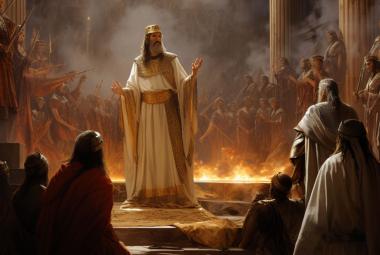Most of us probably have pretty hazy perceptions of our early church history and thus our religious, philosophic, and political roots.
Furthermore, such as they are, our perceptions are inherently skewed toward the West - from the grapple for temporal power by Rome, which was the primary driving force for most of European history between the early church period and modern times.1
Most of us fail to realize that Christianity was first established in the Eastern, or Greek, part of the Roman Empire - not Rome.
Up until 869 A.D., all Ecumenical Councils had been held in or near Constantinople and were in the Greek language. 2
The first three centuries of Christianity were years of persecution by the succession of Roman Emperors - from Nero to Diocletian - that drove it underground.
Yet, by the end of the Imperial Persecutions (313 A.D.), Christians numbered about one-half of the population of the Roman Empire.3
It was the victory at the Battle of Milvain Bridge, just outside Rome, on October 27, 312 A.D. that led to the succession of Constantine to the throne of the Empire, and that turned the tide.
Constantine's Edict of Toleration (313 A.D.) granted to "Christians and to all others full liberty of following that religion which each may choose," thus legalizing Christianity.
And Constantine went even further, favoring Christians in the filling of the chief offices, exempting Christian ministers from taxes and military service, and making Christianity the de facto religion of the court. Thus began the migration from the rags of the caves and catacombs to the silks of the Imperial Court.4
[It was Constantine's second successor, Theodosius II (378-398 A.D.) that would declare Christianity the single state religion of the Empire.]
Eusebius (264-340 A.D.) lived through, and was imprisoned during, Diocletian's persecution of Christians - Rome's final effort to blot out the Christian name. He became the Bishop of Caesarea, the Church Historian, and Constantine's chief religious advisor.
One of Constantine's first acts upon ascending the throne was to order fifty Bibles to be prepared for the instruction of the churches. These were the first Bibles, and included - for the first time - the New Testament as we know it today.
(The Council of Carthage, in 397 A.D., would later give formal ratification to the unanimous judgment of the churches, accepting the 27 books of the New Testament as we know them).
Under Constantine, Sunday was declared a day of rest; slavery, gladiatorial fights, killing of unwelcome children, and crucifixion as a form of execution were also abolished.
The Empire Divided
In 330 A.D., Constantine was so disturbed by the persistence of the Roman aristocracy in their adherence to their pagan religions, and the resulting moral and political atmosphere in Rome, that he moved his Capitol to Byzantium.
He called it Constantinople, the "New Rome," the Capital of the New Christian Empire.
Henceforth, there was rivalry with Rome, of course, and in 395 A.D. the Roman Empire was divided into Eastern and Western legs.5
(Might these be the two "legs" of the dream in Daniel 2? Our end-time prophetic perspectives often overlook the potential significance of the East! There are many prophetic references to the "Little Horns" of Daniel 7 and 8 that indicate he will be from the East.)
In 612-618 A.D. the three Eastern centers of Christianity - Syria, Israel and Egypt-gave way to Islam and Constantinople alone was left.6 Islam was, in a sense, a revolt against the idolatry of the "Christian" world.
From the very first, the East had refused to recognize the primacy of Rome. At the eighth Ecumenical Council (869 A.D.), the final schism occurred between the Greek and Latin Churches.
At times there have been attempts to reunite the churches, but they were futile because the East would not acknowledge the self-imposed authority of the Popes of Rome.
The Greek Church
The Greek Church, now the church of southeastern Europe and Russia, represents approximately one fourth of the world's Christian population.
While similar in many of its practices to the Roman Catholic Church, they do not require celibacy of their priests - they have no "Popes" - and there now has been discovered their early teachings of a pre-millennial, pre-tribulation eschatology.
(Many of the hymns and other traditions of the Greek Church were written by Ephraem of Nisibis. Some of his sermons have been translated into English only recently-and they reveal a pre-trib view!)7
Visit Scheduled
We plan to visit this fabled capital this fall (1998) by means of a Mediterranean cruise, which will also include Israel, Patmos, Ephesus, Philippi, and Athens.
(We have found that nothing is as restful as visiting places from the comfort and convenience of your own stateroom.)
In addition to the usual amenities, our preparatory materials and on-board presentations will help repair our perspectives and prepare us for the visit of a lifetime.
Pray about joining us!
Notes:
- For the shocking summary of this essential background, see our Briefing Package, The Kingdom of Blood.
- Nicea, 325; Constantinople, 381; Ephesus, 431; Chalcedon, 451; Constantinople, 553, and 680; Nicea, 787; and the final schism at Constantinople, 869.
- Much of this has been excerpted from Halley's Bible Handbook, Zondervan Publishing House, Grand Rapids MI, 1965 (originally 1928).
- Christian graves in the catacombs of Rome are estimated to be as many as 7 million. Over 4,000 inscriptions have been found from the period between Tiberius and Constantine.
- This was the first of the two great schisms in Christianity; the second was the Reformation of the 16th century.
- See our Briefing Package, The Sword of Allah for background on the occultic origin and the terrifying agenda of Islam.
- Cf. Personal UPDATE, June 1995, p.12-13.






